Physical Address
304 North Cardinal St.
Dorchester Center, MA 02124
The most common large cyst of the vulva is a cystic dilation of an obstructed Bartholin duct, with a lifetime risk estimated to be 2%. These cysts occur most often during the third decade. Inflamed cysts may be treated with oral antibiotics or incision and drainage.
The vulva contains 1% of the skin surface of the body, but 5% to 10% of all malignant melanomas in women arise from this region. Melanoma is the second most common malignancy arising in the vulva and accounts for 2% to 3% of all of the melanomas occurring in women.
Ideally all vulvar nevi should be excised and examined histologically. Special emphasis should be directed toward the flat junctional nevus and the dysplastic nevus because they have the greatest potential for malignant transformation. The dysplastic nevus is characterized by being more than 5 mm in diameter, with irregular borders and patches of variegated pigment.
The management of nonobstetric vulvar hematomas is usually conservative unless the hematoma is greater than 10 cm in diameter or rapidly increasing.
In adult women, 50% of cases of chronic vulvovaginal pruritus are due to allergic and irritant contact dermatitis. The most common causes of vulvar contact dermatitis are cosmetic and local therapeutic agents. Initial treatment of severe lesions is removal of all irritants or potential allergens and application of topical steroids until the skin returns to normal.
Women usually develop psoriasis during their teenage years, with approximately 3% of adult women being affected. Approximately 20% of these have involvement of the vulvar skin. The margins of psoriasis are better defined than the common skin conditions in the differential diagnosis, including candidiasis, seborrheic dermatitis, and eczema.
Psoriasis does not involve the vagina, only the vulva.
Lichen sclerosus does not involve the vagina, whereas lichen planus may involve the vagina.
Vulvar pain (vulvodynia) is one of the most common gynecologic problems, reported by up to 16% of women in the general population; 30% of women will have spontaneous relief of their symptoms without any treatment.
Classically the symptoms associated with the urethral diverticulum are extremely chronic in nature and do not resolve with multiple courses of oral antibiotic therapy.
Cervical stenosis may occur after loop electrocautery excision procedures (LEEPs). The volume of tissue removed and repeated excisional procedures have been reported to increase the risk for cervical stenosis.
Endocervical polyps are smooth, soft, red, fragile masses found most commonly in multiparous women in their 40s and 50s. After the endocervical polyp is removed, endometrial sampling should be performed to diagnose a coexisting endometrial hyperplasia or carcinoma.
Endometrial polyps are noted in approximately 10% of women when the uterus is examined at autopsy. Approximately one in four women with abnormal bleeding will have an endometrial polyp.
Leiomyomas are the most common benign neoplasms of the uterus. The lifetime prevalence of leiomyomas is greater than 80% among African American women and approaches 70% among white women.
Cytogenetically, leiomyomas are chromosomally normal and arise from a single cell (they are clonal). All the cells are derived from one progenitor myocyte.
Abnormal bleeding is experienced by a third of women with myomas, the most common pattern being intermenstrual spotting. Women with myomas and abnormal bleeding should be thoroughly evaluated for concurrent causes of bleeding.
Adenomyosis is often asymptomatic. If multiple serial sections of the uterus are obtained, the incidence may exceed 60% in women aged 40 to 50 years.
Adenomyosis rarely causes uterine enlargement greater than a size that corresponds to 14 weeks’ gestation unless there is concomitant uterine pathologic change.
The initial management of a suspected follicular cyst is conservative observation. The majority of follicular cysts disappear spontaneously by either reabsorption of the cyst fluid or silent rupture within 4 to 8 weeks of the initial diagnosis.
The practice of aspirating cysts laparoscopically should be limited to cysts that are completely simple and associated with normal CA-125 levels. The intraoperative spillage of malignant cystic tumors should be avoided if possible, although the true risk that spillage poses is unknown.
The differential diagnosis of a woman with acute pain and a suspected ruptured corpus luteum cyst includes ectopic pregnancy, a ruptured endometrioma, and adnexal torsion.
The treatment of unruptured corpus luteum cysts is conservative. However, if the cyst persists or intraperitoneal bleeding occurs, necessitating operation, the treatment is cystectomy.
Drainage or fenestration is effective for follicular cysts and poorly effective for cystadenomas. They will tend to recur. When cysts are drained, it is essential to remember that the cytologic examination of cyst fluid has poor predictive value and poor sensitivity in differentiating benign from malignant cysts.
Theca lutein cysts arise from either prolonged or excessive stimulation of the ovaries by endogenous or exogenous gonadotropins or increased ovarian sensitivity to gonadotropins. The condition of ovarian enlargement secondary to the development of multiple luteinized follicular cysts is termed hyperreactio luteinalis. Approximately 50% of molar pregnancies and 10% of choriocarcinomas have associated bilateral theca lutein cysts.
Benign ovarian teratomas vary from a few millimeters to 25 cm, may be single or multiple, and are bilateral 10% to 15% of the time. Dermoids are believed to arise during fetal life from a single germ cell. They are 46,XX in karyotype.
Operative treatment of benign cystic teratomas is via cystectomy with preservation of as much normal ovarian tissue as possible.
Fifty percent of patients with an ovarian fibroma will have ascites if the tumor is greater than 6 cm. The incidence of associated ascites is directly proportional to the size of the tumor.
Transitional cell tumors (Brenner tumors) are small, smooth, solid, fibroepithelial tumors of the ovary. They usually occur in women between the ages of 40 and 60 and are predominantly unilateral.
Adnexal torsion occurs most commonly in the reproductive years, with the average age of patients being in the mid-20s. Pregnancy predisposes to adnexal torsion.
Ovarian tumors are discovered in 50% to 60% of women with adnexal torsion.
Abnormal color Doppler flow is highly predictive of torsion of the ovary. However, approximately 50% of women with surgically confirmed adnexal torsion will have a normal Doppler flow study.
Conservative surgery, either through the laparoscope or via laparotomy, entails gentle untwisting of the pedicle, possibly cystectomy, and stabilization of the ovary with sutures. Detorsion and fixation of the ovary is a safe procedure that reduces the risk of recurrence.
The risk of pulmonary embolus with adnexal torsion is approximately 0.2%. The risk is similar regardless of whether the condition is managed by conservative surgery with untwisting or adnexal removal without untwisting.
This chapter reviews benign gynecologic lesions; however, the symptoms and differential diagnoses of these lesions have definite similarity with those of malignant disease. As in many areas of medicine, gynecologic problems do not fall into definitive categories, and those that include malignant disease often overlap with those that include benign disease. When the diagnosis from the history, physical examination, and laboratory tests is clear, management is usually self-evident. When a specific diagnosis is unclear, tissue biopsy may be appropriate. Thus the clinical approach to patient complaints or findings must be broad and not so focused as to prematurely exclude dangerous pathologic conditions within the differential diagnosis.
The discussions in this chapter are arranged anatomically, beginning with the vulva and subsequently covering the vagina, cervix, uterus, oviducts, and ovaries. This chapter does not attempt to be encyclopedic; rather, lesions have been selected based on their clinical importance and prevalence. Therefore extremely rare lesions have been omitted. Because several nonneoplastic abnormalities and lesions present in ways similar to those of benign tumors, this chapter also discusses entities that are not specifically abnormal growths. Clinical problems such as torsion of the ovary, lacerations of the vagina, and hematomas of the vulva are examples of common conditions included in this chapter. Gynecologic infections and associated changes are discussed in Chapter 23 .
The successful clinician uses both deductive and inductive reasoning in making a diagnosis. To master both these techniques, one must be adept at history taking and physical examination and be able to form a complete list of possible causes that may be related to the patient’s complaint. An understanding of the problems discussed in this chapter will be helpful in that endeavor.
Urethral caruncle and urethral prolapse are conditions that primarily affect postmenopausal women and premenarchal girls. They are thought to occur as a result of decreased estrogen. A urethral caruncle is a small, fleshy mass that occurs at the posterior portion of the urethral meatus. The tissue of the caruncle is soft, smooth, friable, and bright red and initially appears as an eversion of the urethra ( Fig. 18.1 ). Urethral caruncles are generally small, single, and sessile, but they may be pedunculated and grow to be 1 to 2 cm in diameter. Urethral caruncles are believed to arise from an ectropion of the posterior urethral wall associated with retraction and atrophy of the postmenopausal vagina. The growth of the caruncle is secondary to chronic irritation or infection.
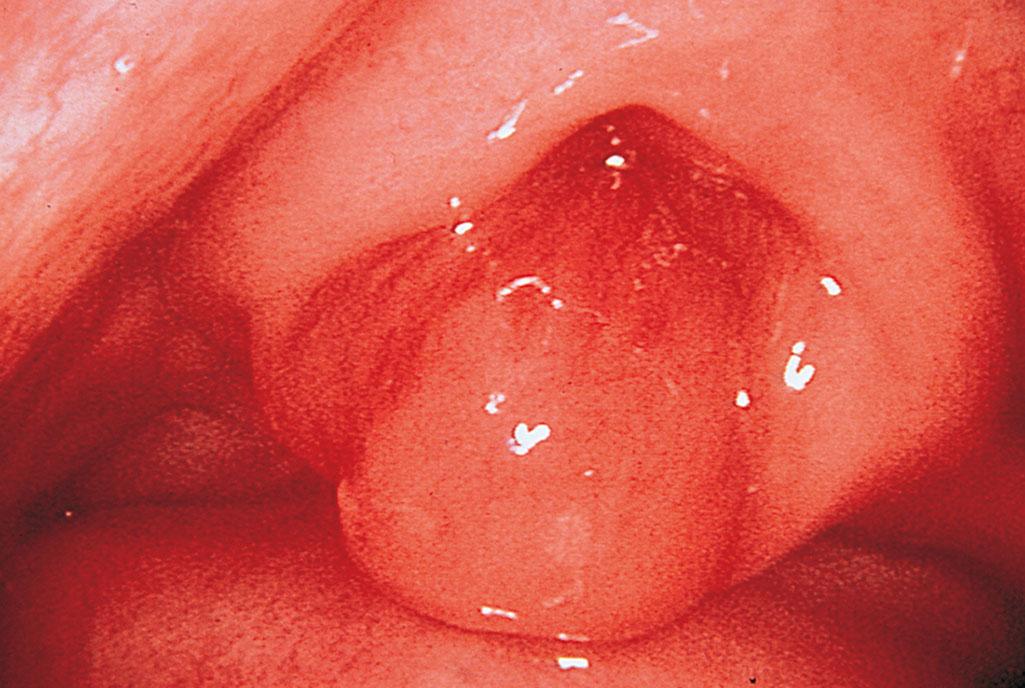
Histologically the caruncle is composed of transitional and stratified squamous epithelium with a loose connective tissue, and often the submucosal layer contains relatively large dilated veins. Caruncles are often subdivided by their histologic appearance into papillomatous, granulomatous, and angiomatous varieties.
They are often secondarily infected, producing ulceration and bleeding. The symptoms associated with urethral caruncles are variable. Many women are asymptomatic, whereas others experience dysuria, frequency, and urgency. Sometimes the caruncle produces point tenderness after contact with undergarments or during intercourse. Ulcerative lesions usually produce spotting on contact more commonly than hematuria. The diagnosis of a urethral caruncle is established by biopsy under local anesthesia because it can appear similar to a neoplasm.
Initial therapy is oral or topical estrogen and avoidance of irritation. If the caruncle does not regress or is symptomatic, it may be destroyed by cryosurgery, laser therapy, fulguration, or operative excision. After operative destruction, a Foley catheter is usually left in place for 48 to 72 hours to prevent urinary retention. Follow-up is necessary to ensure that the patient does not develop urethral stenosis. It is not uncommon for the caruncle to recur. Small, asymptomatic urethral caruncles do not need treatment.
Urethral prolapse is predominantly a disease of the premenarcheal girl, although it can occur in postmenopausal women ( Fig. 18.2 ). Patients may have dysuria; however, most are asymptomatic. The annular rosette of friable, edematous, prolapsed mucosa does not have the bright red color of a caruncle and is easily distinguished from a caruncle because it is circumferential ( ). It may be ulcerated with necrosis or grossly edematous. Therapy for a prolapsed urethra is hot sitz baths and antibiotics to reduce inflammation and infection. Topical estrogen cream is sometimes an effective treatment. In rare cases it may be necessary to excise the redundant mucosa.
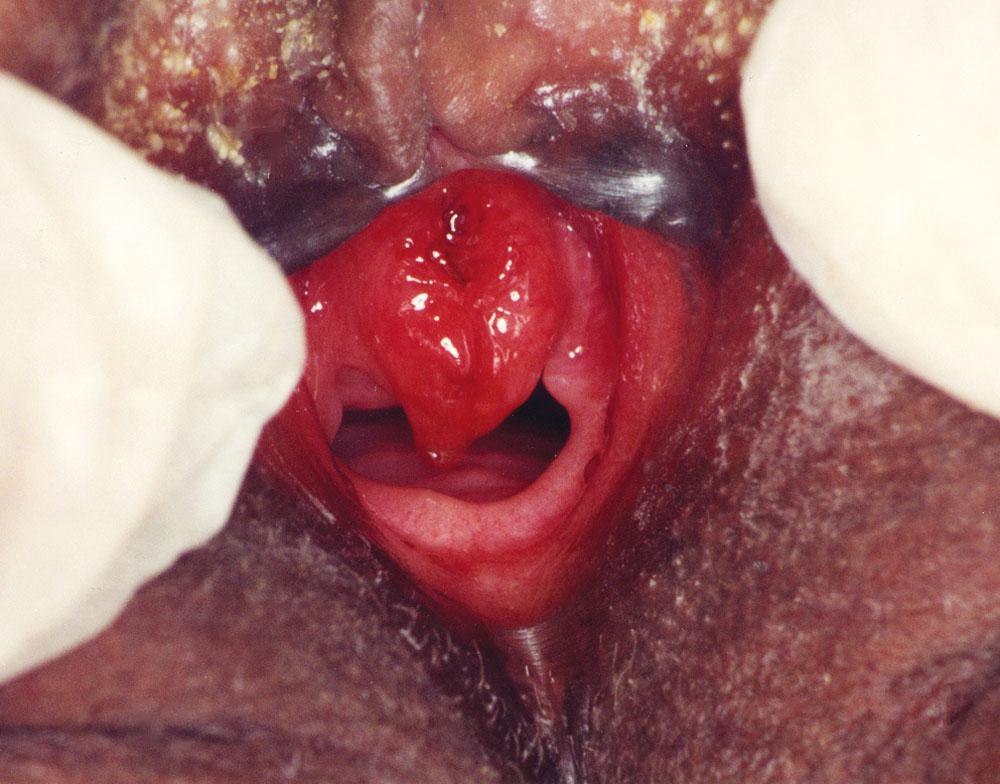
The differential diagnosis of urethral caruncles includes primary carcinoma of the urethra and prolapse of the urethral mucosa. Malignant lesions are usually hard and irregular in shape and typically are within the urethra itself ( ). Urethral carcinoma is primarily a disease in elderly women. The symptoms of a urethral carcinoma include bleeding, urinary frequency, and dysuria. The majority of urethral carcinomas are of squamous cell origin. Most of these rare carcinomas arise from the distal urethra.
The differential diagnosis of a periurethral mass also includes urethral diverticulum, leiomyoma, vaginal wall inclusion cyst, Skene gland cyst or abscess, and, less commonly, Gartner duct cyst and ectopic ureterocele ( ). These are discussed later in this chapter in the Vagina section.
The most common large cyst of the vulva is a cystic dilation of an obstructed Bartholin duct. Bartholin glands open into the vulvar vestibule at about the 5 and 7 o’clock position, distal to the hymenal ring. Bartholin duct cysts and abscesses are fairly common, with a lifetime risk estimated to be 2% ( ). They occur most often during the third decade. Noninflamed cysts contain sterile, clear, mucinous fluid. They do not require treatment unless large enough to cause discomfort. Inflamed cysts may be treated with oral antibiotics or incision and drainage. Lesions in the Bartholin gland can occur as carcinomas, a rare tumor that accounts for 2% to 7% of vulvar carcinomas.
Occasionally the ducts of mucous glands of the vestibule become occluded. The resulting small cysts (usually 0.5 to 2 cm) may be clear, yellow, or blue. Similar small mucous cysts occur in the periurethral region. Wolffian duct cysts or mesonephric cysts are rare, but when they do occur, they are found near the clitoris and lateral to the hymeneal ring. These cysts have thin walls and contain clear serous fluid.
Skene duct cysts are rare, usually small, located on the anterior wall of the vagina along the distal urethra, and may present with symptoms of discomfort or be found on routine examination. These cysts arise secondary to infection and scarring of the small ducts ( Fig. 18.3 ). The differential diagnosis includes urethral diverticula; however, clinically, physical compression of the cyst, unlike compression of a urethral diverticula, should not produce fluid from the urethral meatus. Imaging studies such as magnetic resonance imaging (MRI) and ultrasound may also assist in establishing the diagnosis. Asymptomatic cysts in premenopausal women may be managed conservatively. Treatment is excision with careful dissection to avoid urethral injury.
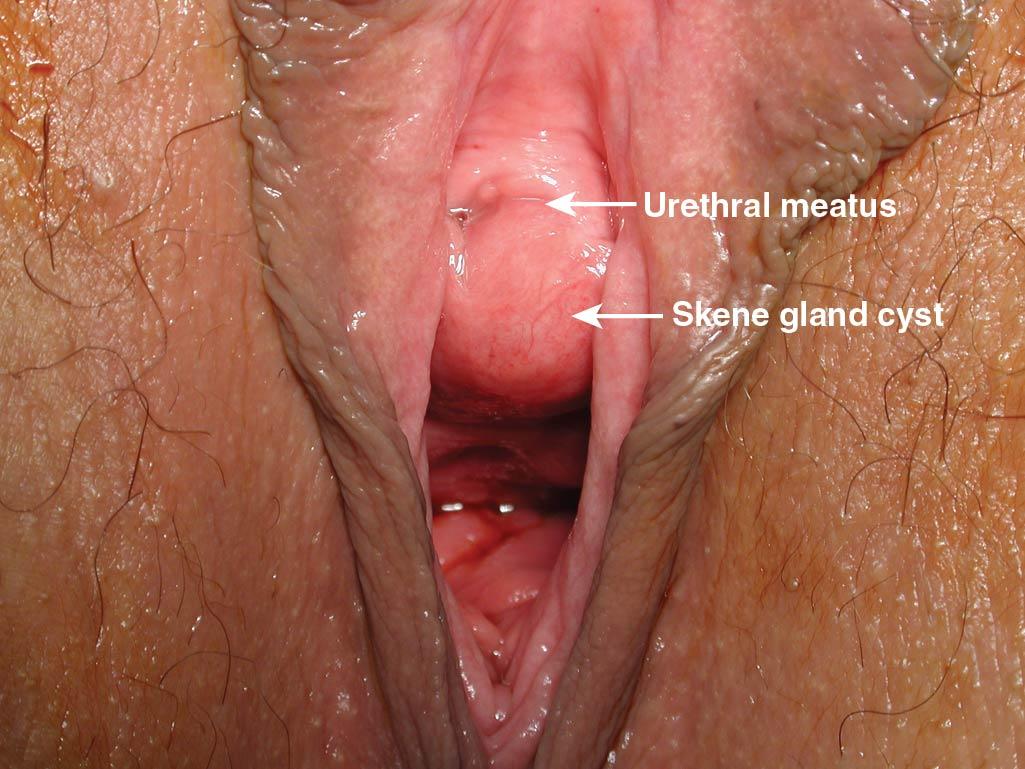
The most common small vulvar cysts are epidermal (or epidermoid) cysts, which are firm, smooth-surfaced, white, yellow, slightly pink, or skin-colored papules or nodules averaging 0.5 to 2 cm in size ( ). They are most commonly located on the hair-bearing areas. One or several lesions may be present, usually nontender and slow growing. They are firm to shotty in consistency, and their contents are usually under pressure. When noninflamed, they are asymptomatic and no treatment is necessary. If confirmation is needed, incision reveals white, caseous material, like thick cheese. Vulvar epidermal cysts do not have sebaceous cells or sebaceous material identified on microscopic examination but have keratin produced by keratinocytes in the lining of the cyst wall ( ). With rupture or leakage of a cyst, inflammation can occur, necessitating treatment with heat applied locally and possibly incision and drainage. Cysts that become recurrently infected or produce pain should be excised when the acute inflammation has subsided. The typical epidermoid cyst develops from embryonic remnants of an anatomically malformed pilosebaceous unit.
An “inclusion cyst” may arise when bits of epithelium are implanted in the skin during surgery or trauma sufficient to break the skin surface. These may be seen at the site of an episiotomy or obstetric laceration. Large epidermal cysts may be confused with fibromas, lipomas, and hidradenomas.
A nevus, commonly referred to as a mole, is a localized nest or cluster of melanocytes. These undifferentiated cells arise from the embryonic neural crest and are present from birth. Many nevi are not recognized until they become pigmented at the time of puberty. Vulvar nevi are one of the most common benign neoplasms in women. As with nevi in other parts of the body, they exhibit a wide range in depth of color, from blue to dark brown to black, and some may be amelanotic. The diameter of most common nevi ranges from a 3 to 10 mm. Grossly a benign nevus may be flat, elevated, or pedunculated. The borders are sharp, the color even, and the shape is symmetric. Dysplastic nevi are commonly 6 to 20 mm with one or more atypical features such as speckling of color, diffuse margination, additional red, white, or blue hues, and asymmetry. Other pigmented lesions in the differential diagnosis include hemangiomas, endometriosis, malignant melanoma, vulvar intraepithelial neoplasia, and seborrheic keratosis.
Vulvar nevi are generally asymptomatic. Most women do not closely inspect their vulvar skin; however, during examination, the use of a mirror held by the patient may facilitate teaching self-vulvar exam. Histologically the lesions are subdivided into three major groups: junctional (a symmetric macule), compound, and intradermal nevi (both papules) ( Fig. 18.4 ).
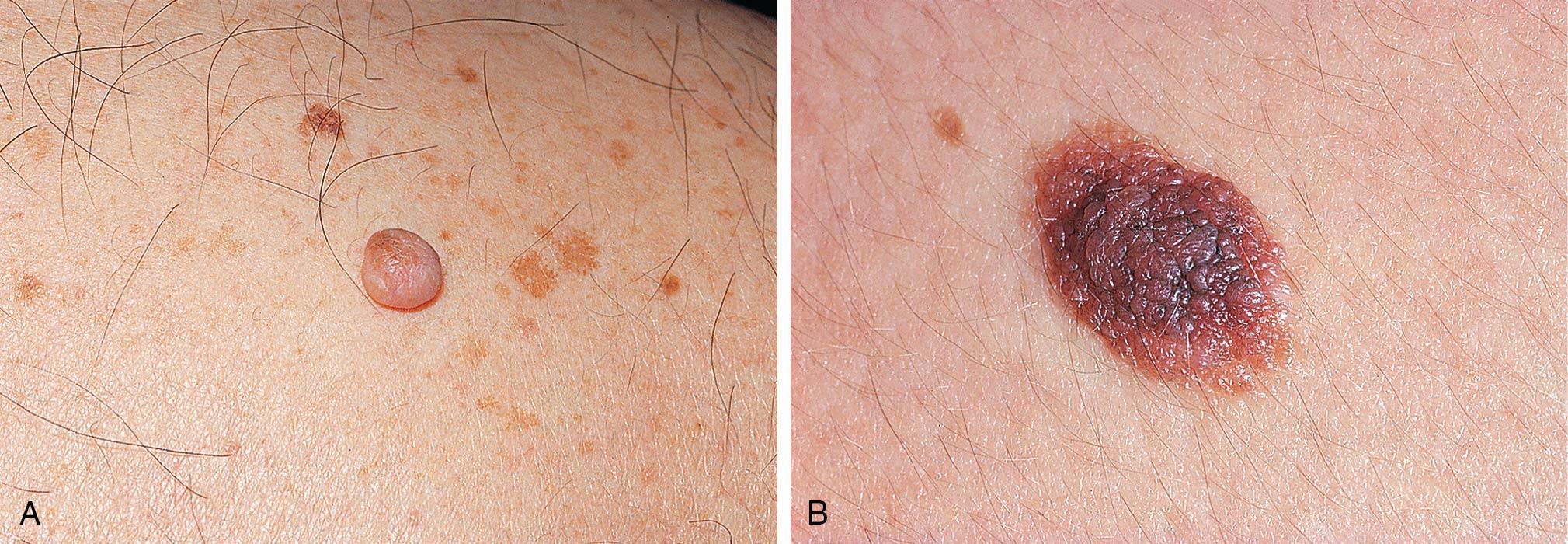
Melanoma is the second most common malignancy arising in the vulva and accounts for 2% to 3% of all of the melanomas occurring in women, even though the vulva contains approximately 1% of the skin surface area of the body. The incidence of vulvar melanoma is stable or slightly decreasing. It is more common in older, white women, with a mean age at diagnosis of 68 years ( ). It is estimated that 50% of malignant melanomas arise from a preexisting nevus. Family history of melanoma is one of the strongest risk factors for the disease.
Ideally, all vulvar nevi should be excised and examined histologically. Special emphasis should be directed toward the flat junctional nevus and the dysplastic nevus because they have the greatest potential for malignant transformation ( Fig. 18.5 ). The lifetime risk of a woman developing melanoma from a congenital junctional nevus that measures greater than 2 cm in diameter is estimated to be approximately 10%. The lifetime risk of a melanoma forming in women with dysplastic nevi is 15 times that of the general population.
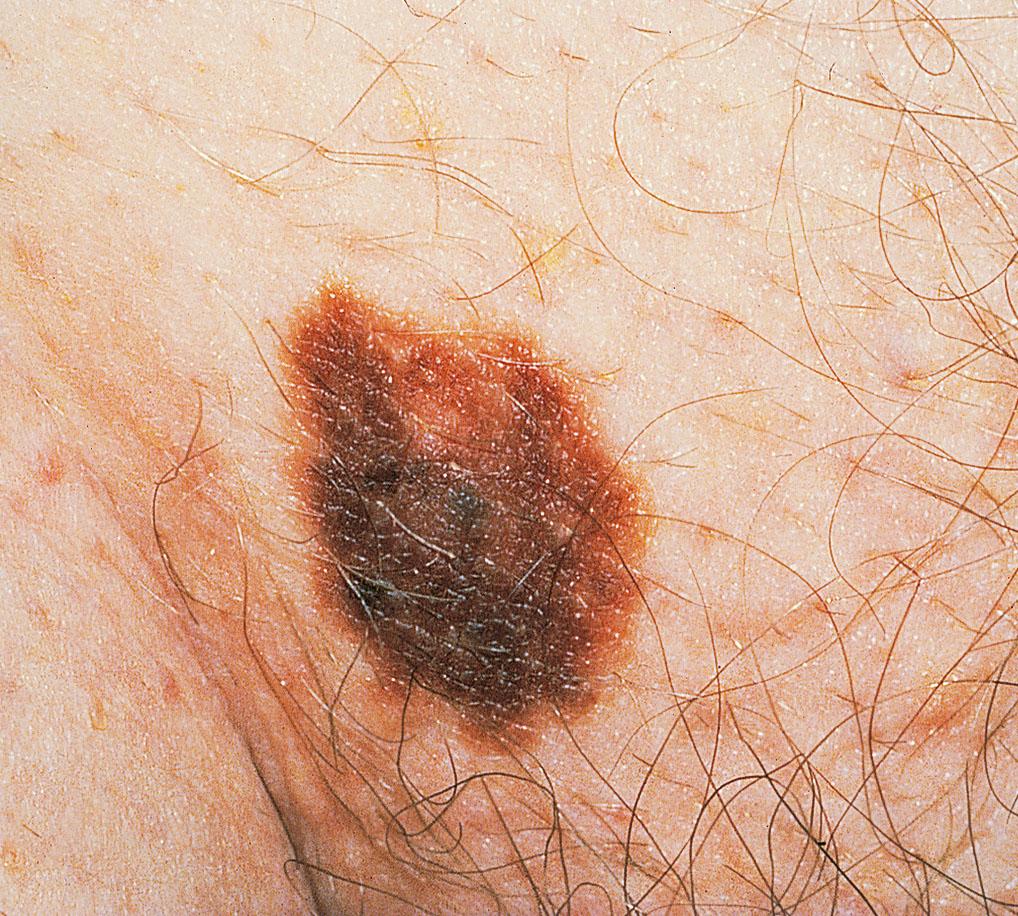
Removal may be accomplished with local anesthesia or coincidentally with obstetric delivery or gynecologic surgery. Proper excisional biopsy should be three-dimensional and adequate in width and depth. Approximately 5 to 10 mm of normal skin surrounding the nevus should be included, and the biopsy specimen should include the underlying dermis as well.
Some patients are reluctant to have a “normal” appearing nevus removed. Nevi that are raised or contain hair rarely undergo malignant change. However, if they are often irritated or bleed spontaneously, they should be removed. Recent changes in growth or color, ulceration, bleeding, pain, or the development of satellite lesions mandate biopsy. The characteristic clinical features of an early malignant melanoma may be remembered by thinking ABCD: asymmetry, border irregularity, color variegation, and a diameter usually greater than 6 mm.
Hemangiomas are rare malformations of blood vessels rather than true neoplasms. Vulvar hemangiomas often are discovered initially during childhood. They are usually single, 1 to 2 cm in diameter, flat, and soft, and they range in color from brown to red or purple. Histologically the multiple channels of hemangiomas are predominantly thin-walled capillaries arranged randomly and separated by thin connective tissue septa. These tumors change in size with compression and are not encapsulated. Most hemangiomas are asymptomatic; occasionally they may become ulcerated and bleed.
There are at least five different types of vulvar hemangiomas. The strawberry and cavernous hemangiomas are congenital defects discovered in young children. The strawberry hemangioma is usually bright red to dark red, is elevated, and rarely increases in size after age 2. Approximately 60% of vulvar hemangiomas discovered during the first years of life spontaneously regress in size by the time the child goes to school. Cavernous hemangiomas are usually purple and vary in size, with the larger lesions extending deeply into the subcutaneous tissue. These hemangiomas initially appear during the first few months of life and may increase in size until age 2. Similar to strawberry hemangiomas, spontaneous resolution generally occurs before age 6. Senile or cherry angiomas are common small lesions that arise on the labia majora, usually in postmenopausal women. They are most often less than 3 mm in diameter, multiple, and red-brown to dark blue. Angiokeratomas are approximately twice the size of cherry angiomas, are purple or dark red, and occur in women between the ages of 30 and 50. They are noted for their rapid growth and tendency to bleed during strenuous exercise. In the differential diagnosis of an angiokeratoma is Kaposi sarcoma and angiosarcoma. Pyogenic granulomas are an overgrowth of inflamed granulation tissue that grow under the hormonal influence of pregnancy, with similarities to lesions in the oral cavity. Pyogenic granulomas are usually small, slightly pedunculated nodules approximately 1 cm in diameter, appearing “pinched in” at the base. They may be mistaken clinically for malignant melanomas, basal cell carcinomas, vulvar condylomas, or nevi. Treatment of pyogenic granulomas involves wide and deep excision to prevent recurrence.
The diagnosis is usually established by gross inspection of the vascular lesion. Asymptomatic hemangiomas and hemangiomas in children rarely require therapy. In adults, initial treatment of large symptomatic hemangiomas that are bleeding or infected may require subtotal resection. When the differential diagnosis is questionable, excisional biopsy should be performed. A hemangioma that is associated with troublesome bleeding may be destroyed by cryosurgery, sclerotherapy, or with the use of lasers. Cryosurgical treatment usually involves a single freeze/thaw cycle repeated three times at monthly intervals. Obviously, if the histologic diagnosis is questionable, any bleeding vulvar mass should be treated by excisional biopsy so that the definitive pathologic diagnosis can be established. Surgical removal of a large, cavernous hemangioma may be technically difficult. Lymphangiomas of the vulva do exist but are extremely rare.
Another rare malformation is the vulvar venous malformation. These lesions may become symptomatic at any age and are relatively prone to thrombosis. Venous malformations are different from vulvar varicosities, which are exacerbated with pregnancy and tend to regress postpartum. There are reports of the successful use of sclerotherapy for the treatment of the malformations.
Fibromas are the most common benign solid tumors of the vulva. They are more common than lipomas, the other common benign tumors of mesenchymal origin. Fibromas occur in all age groups and most commonly are found in the labia majora ( Fig. 18.6 ). However, they actually arise from deeper connective tissue. Thus they should be considered as dermatofibromas. They grow slowly and vary from a few centimeters to one gigantic vulvar fibroma reported to weigh more than 250 pounds. Most are between 1 and 10 cm in diameter. The smaller fibromas are discovered as subcutaneous nodules. As they increase in size and weight, they become pedunculated. Smaller fibromas are firm; however, larger tumors often become cystic after undergoing myxomatous degeneration. Sometimes the vulvar skin over a fibroma is compromised by pressure and ulcerates.
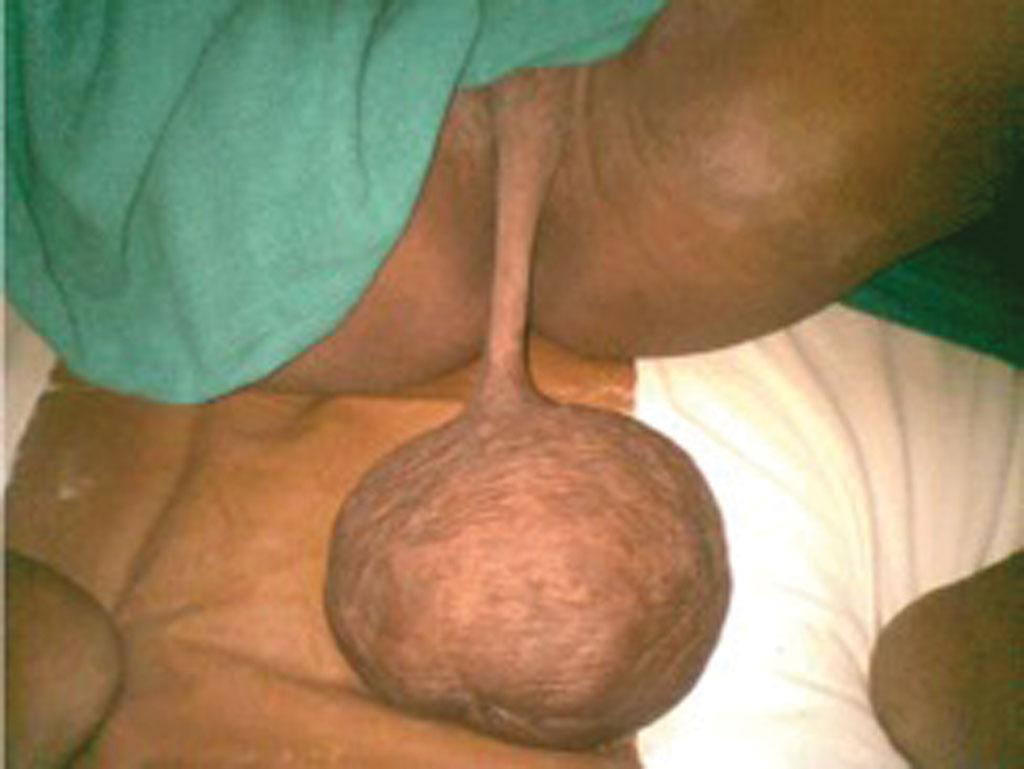
Fibromas have a smooth surface and a distinct contour. On cut surface the tissue is gray-white. Fat or muscle cells microscopically may be associated with the interlacing fibroblasts. Fibromas have a low-grade potential for becoming malignant. Smaller fibromas are asymptomatic; larger ones may produce chronic pressure symptoms or acute pain when they degenerate. Treatment is operative removal if the fibromas are symptomatic or continue to grow. Occasionally they are removed for cosmetic reasons.
Lipomas are the second most common type of benign vulvar mesenchymal tumor. A common hamartoma of fat, lipomas of the vulva are similar to lipomas of other parts of the body. In the vulva, they are most commonly located periclitorally or within the labia majora ( ). When discovered they are softer and usually larger than fibromas ( Fig. 18.7 ). The majority of lipomas in the vulvar region are smaller than 3 cm. The largest vulvar lipoma reported in the literature weighed 44 pounds. They are slow growing, and their malignant potential is extremely low.
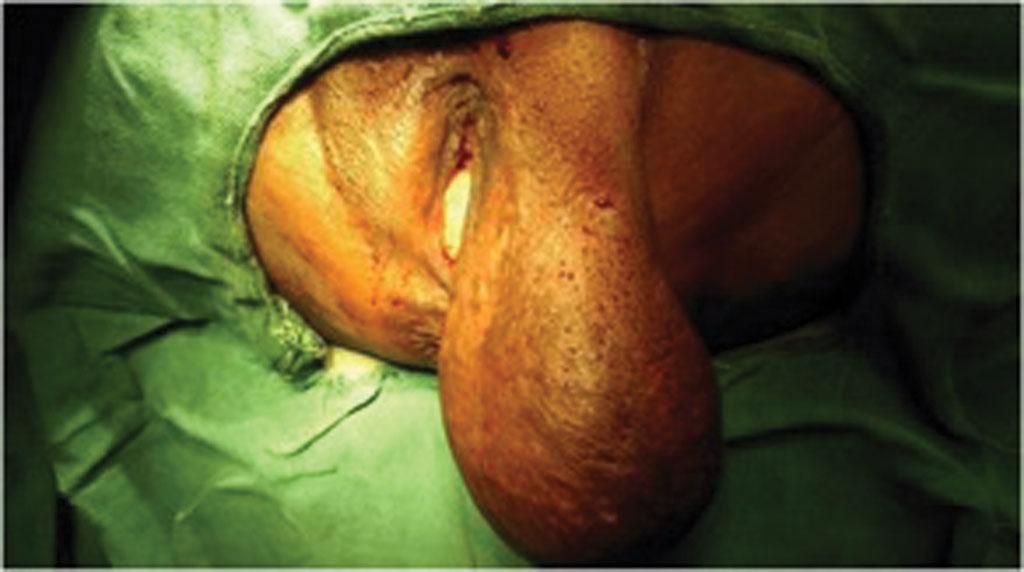
When a lipoma is cut, the substance is soft, yellow, and lobulated. Histologically, lipomas are usually more homogeneous than fibromas. Prominent areas of connective tissue occasionally are associated with the mature adipose cells of a true lipoma. Unless extremely large, lipomas do not produce symptoms. Computed tomography and MRI may be used to evaluate tumor extensions and anatomic connections with surrounding structures. MRI has been reported to facilitate the differentiation of vulvar lipomas from vulvar liposarcomas ( ). Excision is usually performed to establish the diagnosis, although smaller tumors may be followed conservatively.
The hidradenoma is a rare, small, benign vulvar tumor thought to be derived from mammary-like glands located in the anogenital area of women ( Fig. 18.8 ). In a review of 46 cases, the tumors occurred only in postpubertal women aged 30 to 90 ( ). Clinically, hidradenoma are small, smooth-surfaced, medium soft to firm nodules found most commonly on the labia majora or labia minora. They appear cystic and are usually asymptomatic; however, some patients report itching, bleeding, and mild pain. Hidradenomas may be cystic or solid, and approximately 50% are less than 1 cm in diameter. These tumors have well-defined capsules and arise deep in the dermis. Histologically, because of its hyperplastic, adenomatous pattern, a hidradenoma may be mistaken at first glance for an adenocarcinoma. On close inspection, however, although there is glandular hyperplasia with numerous tubular ducts, there is a paucity of mitotic figures and a lack of significant cellular and nuclear pleomorphism ( Fig. 18.9 ). Excisional biopsy is the treatment of choice.
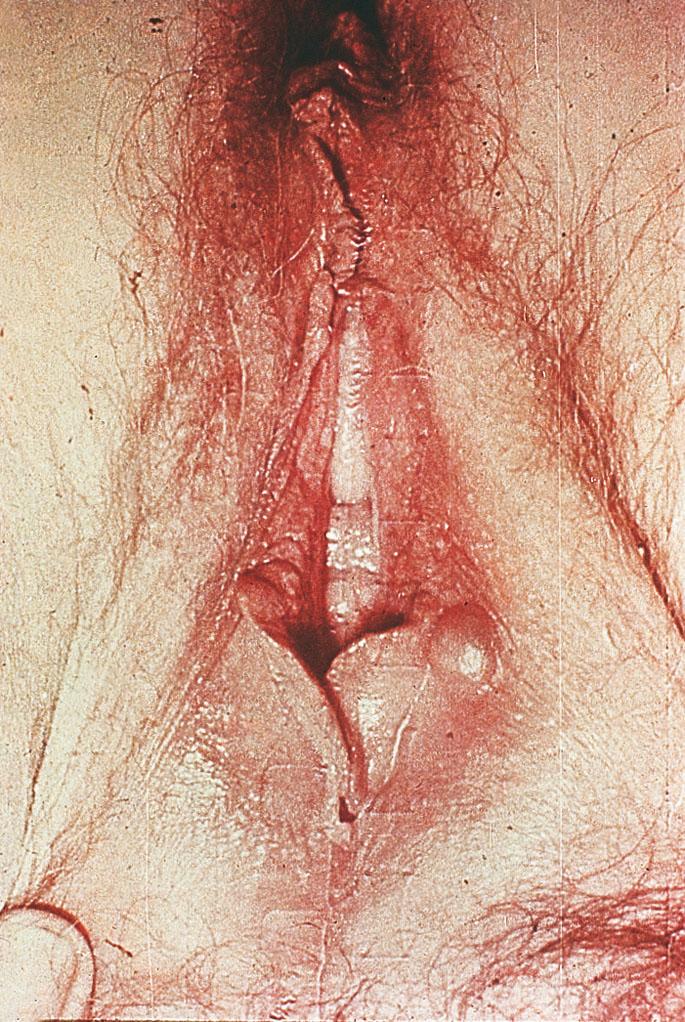
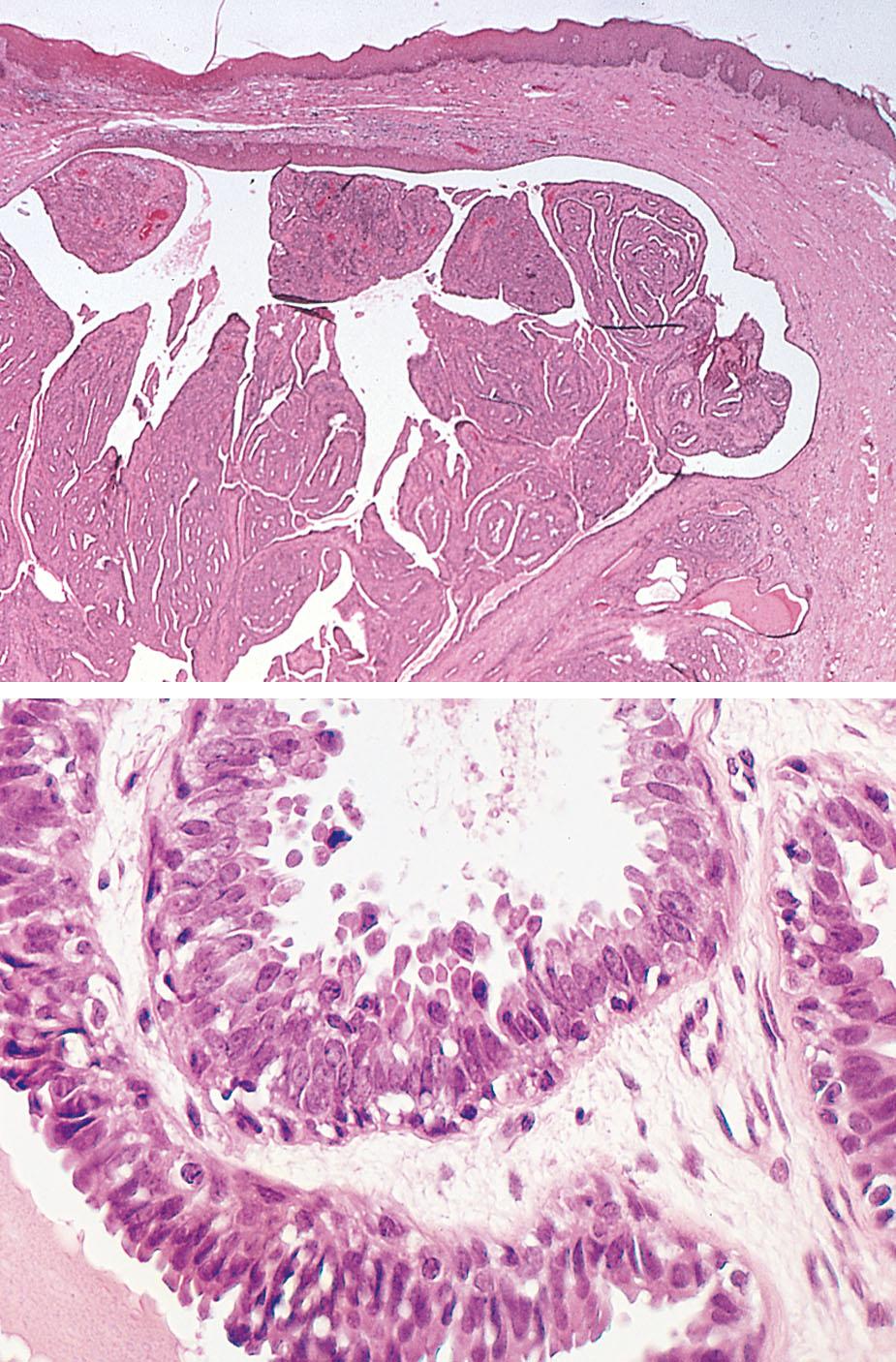
The syringoma is a benign skin adnexal neoplasm thought to be of eccrine origin. It is common on the face and eyelids but unusual on the vulva. In the vulvar area these small, asymptomatic papules (usually less than 5 mm in diameter) are located on the labia majora. The papules are skin colored or yellow and may coalesce to form cords of firm tissue. They may be hormonally active because pregnancy may aggravate associated pruritus and progesterone receptors have been detected in this neoplasm ( ). This tumor is usually treated by excisional biopsy, cryosurgery, or laser therapy. The most common differential diagnosis is Fox-Fordyce disease, a condition of multiple retention cysts of apocrine glands accompanied by inflammation of the skin. The latter disease often produces intense pruritus, whereas syringoma is generally asymptomatic. Fox-Fordyce disease improves with pregnancy and oral contraceptive use and remits after menopause. It is treated with topical steroids, topical tretinoin cream, and oral isotretinoin.
Endometriosis of the vulva is uncommon. Only 1 in 500 women with endometriosis present with vulvar lesions. The firm, small nodule or nodules may be cystic or solid and vary from a few millimeters to several centimeters in diameter. The subcutaneous lesions are blue, red, or purple, depending on their size, activity, and closeness to the surface of the skin. The gross and microscopic pathologic picture of vulvar endometriosis is similar to endometriosis of the pelvis (see Chapter 19 ). Vulvar adenosis may appear similar to endometriosis. The former condition occurs after laser therapy of condylomata acuminata.
Endometriosis of the vulva is usually found at the site of an old, healed obstetric laceration, an episiotomy site, an area of operative removal of a Bartholin duct cyst, or along the canal of Nuck. The pathophysiology of vulvar endometriosis development may be secondary to metaplasia, retrograde lymphatic spread, or potential implantation of endometrial tissue during operation. In one series, 15 cases of vulvar endometriosis were believed to be associated with prophylactic postpartum curettage performed in 2028 deliveries, since there was not a single case in 13,800 deliveries without curettage. In general, symptoms do not appear for many months after implantation.
The most common symptoms of endometriosis of the vulva are pain and introital dyspareunia. The classic history is cyclic discomfort and an enlargement of the mass associated with menstrual periods. Treatment of vulvar endometriosis is by wide excision or laser vaporization depending on the size of the mass. Recurrences are common after inadequate operative removal of the entire involved area, and as a result most would also recommend medical therapy with continuous oral contraceptives, progestins, or gonadotropin-releasing hormone (GnRH) agonists.
Granular cell myoblastoma is a rare, slow-growing, solid vulvar tumor originating from neural sheath (Schwann) cells and is sometimes called a schwannoma. These tumors are found in connective tissues throughout the body, most commonly in the tongue, and occur in any age group. Approximately 7% of solitary granular cell myoblastomas are found in the subcutaneous tissue of the vulva. Twenty percent of multiple granular cell myoblastomas are located in the vulva. The tumors are usually located in the labia majora but occasionally involve the clitoris.
These tumors are subcutaneous nodules, usually 1 to 5 cm in diameter. They are benign but characteristically infiltrate the surrounding local tissue. The tumors are slow growing, but as they grow, they may cause ulcerations in the skin. The overlying skin often has hyperplastic changes that may look similar to invasive squamous cell carcinoma. Grossly these tumors are not encapsulated, and the cut surface of the tumor is yellow. Histologically, there are irregularly arranged bundles of large, round cells with indistinct borders and pink-staining cytoplasm. Initially the cell of origin was believed to be striated muscle; however, electron microscopic studies have demonstrated that this tumor is from cells of the neural sheath.
The tumor nodules are painless. Treatment involves wide excision to remove the filamentous projections into the surrounding tissue. If the initial excisional biopsy is not sufficiently aggressive, these benign tumors tend to recur. Recurrence occurs in approximately one in five of these vulvar tumors. The appropriate therapy is a second operation with wider margins, as these tumors are not radiosensitive.
The vulva is sometimes involved with the benign neural sheath tumors of von Recklinghausen disease (generalized neurofibromatosis and café-au-lait spots). The vulvar lesions of this disease are fleshy, brownish red, polypoid tumors. Approximately 18% of women with von Recklinghausen disease have vulvar involvement. Excision is the treatment of choice for symptomatic tumors.
The differential diagnosis of vulvar masses includes a large array of rare lesions and aberrant tissues, including leiomyomas, squamous papillomas, sebaceous adenomas, dermoids, accessory breast tissue and müllerian or wolffian duct remnants, epidermal inclusion cysts, sebaceous cysts, mucous cysts, and skin diseases such as seborrheic keratosis, condylomata acuminata, and molluscum contagiosum. Some of these diseases are discussed in this chapter, others in Chapter 23 .
Hematomas of the vulva are usually secondary to blunt trauma such as a straddle injury from a fall, an automobile accident, or a physical assault. Traumatic injuries producing vulvar hematomas have been reported secondary to a wide range of recreational activities, including bicycle, motorcycle, and go-cart riding; sledding; water skiing; cross-country skiing; and amusement park rides ( Fig. 18.10 ). Spontaneous hematomas are rare and usually occur from rupture of a varicose vein during pregnancy or the postpartum period.
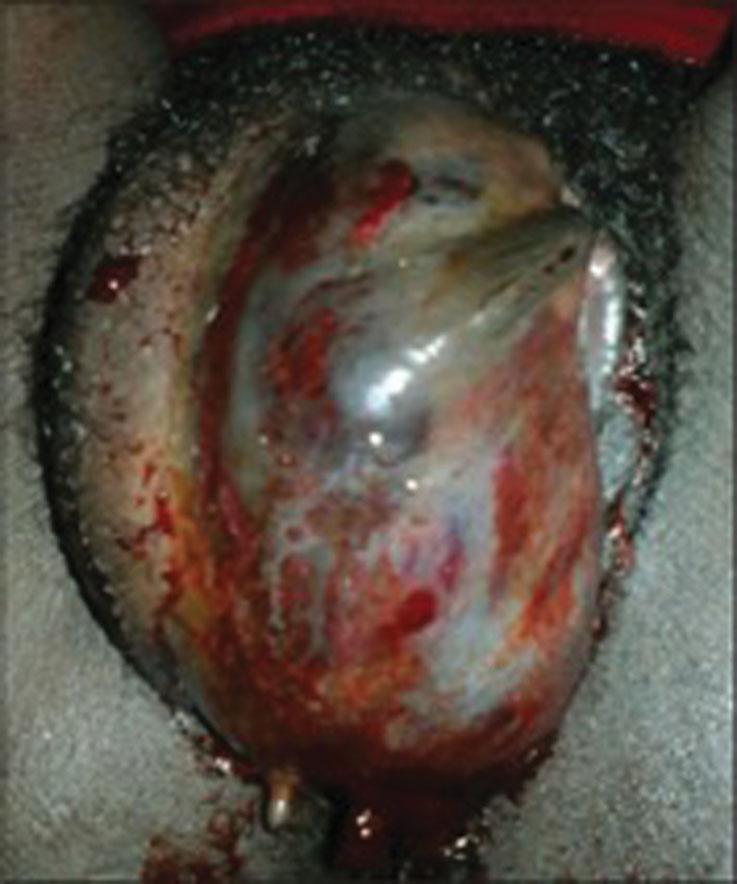
The management of nonobstetric vulvar hematomas is usually conservative unless the hematoma is greater than 10 cm in diameter or is rapidly expanding. The bleeding that produces a vulvar hematoma is usually venous in origin. Therefore it may be controlled by direct pressure. Compression and application of an ice pack to the area are appropriate therapy. If the hematoma continues to expand, operative therapy is indicated in an attempt to identify and ligate the damaged vessel. Often identification of the “key responsible vein” is a futile operative procedure. However, obvious bleeding vessels are ligated, and a pack is placed to promote hemostasis. During the operation, careful inspection and, if needed, endoscopy are performed to rule out injury to the urinary bladder and rectosigmoid.
The majority of small hematomas regress with time; however, a “chronic expanding hematoma” may become particularly problematic. The most familiar clinical example of this type of problem is the chronic subdural hematoma, but a similar situation may accompany vulvar hematomas. The underlying pathophysiology is repetitive episodes of bleeding from capillaries in the granulation tissue of the hematoma, which result in a chronic, slowly expanding vulvar mass. Treatment of a chronic expanding hematoma is drainage and debridement.
The skin of the vulva is similar to the skin over any surface of the body and is therefore susceptible to any generalized skin disease or involvement by systemic disease. The most common skin diseases involving the vulva include contact dermatitis, neurodermatitis, psoriasis, seborrheic dermatitis, cutaneous candidiasis, and lichen planus. The majority of vulvar skin problems are red, scalelike rashes, and the woman’s primary complaint is of pruritus. The diagnosis and treatment of these lesions are often obscured or modified by the environment of the vulva. The combination of moisture and heat of the intertriginous areas may produce irritation, maceration, and a wet, weeping surface. Patients will commonly apply ointments and lotions, which may produce secondary irritation. Therefore it is important that the gynecologist examine the skin of the entire body because the patient may have more classic lesions of the dermatologic disease in another location. The skin of the vulva is susceptible to acute infections produced by Streptococcus or Staphylococcus, such as folliculitis, furunculitis, impetigo, and a chronic infection, hidradenitis suppurativa.
The nonspecific symptom complex of vulvar pruritus and burning is presented next as an introduction to the discussion of dermatologic diseases of the vulva.
Pruritus is the single most common gynecologic problem; it is a symptom of intense itching with an associated desire to scratch and rub the affected area. Not uncommonly, secondary vulvar pain develops in association or subsequent to pruritus. In some women pruritus becomes an almost unrelenting symptom, with the development of repetitive “itch-scratch” cycles. The itch-scratch cycle is a complex of itching leading to scratching, producing excoriation and then healing. The healing skin itches, leading to further scratching. Pruritus is a nonspecific symptom. The differential diagnosis includes a wide range of vulvar diseases, including skin infections, sexually transmitted diseases, specific dermatosis, vulvar dystrophies, lichen sclerosus, premalignant and malignant disease; contact dermatitis; neurodermatitis; atrophy; diabetes; drug allergies; vitamin deficiencies; pediculosis, scabies; psychological causes; and systemic diseases such as leukemia and uremia.
The management of pruritus involves establishing a diagnosis, treating the offending cause, and improving local hygiene. For successful treatment the itch-scratch cycle must be interrupted before the condition becomes chronic, resulting in lichenification of the skin (lichen simplex chronicus). Lichenification clinically is recognized by palpably thickened skin, exaggerated skin markings, and lichen-type scale. The resulting dry, scaly skin often cracks, forms fissures, and becomes secondarily infected, thus complicating the treatment (see Chapter 30 ).
The vulvar skin, especially the intertriginous areas, is a common site of contact dermatitis. The vulvar skin is more reactive to exposure by irritants than other skin areas such as the extremities. Contact dermatitis is usually caused by one of two basic pathophysiologic processes: a primary irritant (nonimmunologic) or a definite allergic (immunologic) origin. A large proportion of adult patients with chronic vulvovaginal pruritis are symptomatic because of contact dermatitis. Substances that are irritants produce immediate symptoms such as a stinging and burning sensation when applied to the vulvar skin. The symptoms and signs secondary to an irritant disappear within 12 hours of discontinuing the offending substance. In contrast, allergic contact dermatitis requires 36 to 48 hours to manifest its symptoms and signs.
Allergic contact dermatitis is a cell-mediated delayed-type (type IV) hypersensitivity reaction. There is development of antigen-specific T cells that may return to the skin at the next contact with the allergen. Often the signs of allergic contact dermatitis persist for several days despite removal of the allergen. Rarely, some women will be allergic to latex or semen. These elicit type 1, immunoglobulin E (IgE)–mediated, immediate reactions. Angioedema and urticarial plaques and papules arise within minutes of contact, and anaphylaxis may result.
Excessive cleansing of the vulvar skin and urinary or fecal incontinence may precipitate an irritant dermatitis. The majority of chemicals that produce hypersensitivity of the vulvar skin are cosmetic or therapeutic agents, including vaginal contraceptives, lubricants, sprays, perfumes, douches, fabric dyes, fabric softeners, synthetic fibers, bleaches, soaps, chlorine, dyes in toilet tissues, and local anesthetic creams ( Fig. 18.11 ). External chemicals that trigger the disease process must be avoided. Some of the most severe cases of contact dermatitis involve lesions of the vulvar skin secondary to poison ivy or poison oak. Women with a history of atopy or eczema are more at risk for contact dermatitis and tend to be more sensitive to skin irritations.
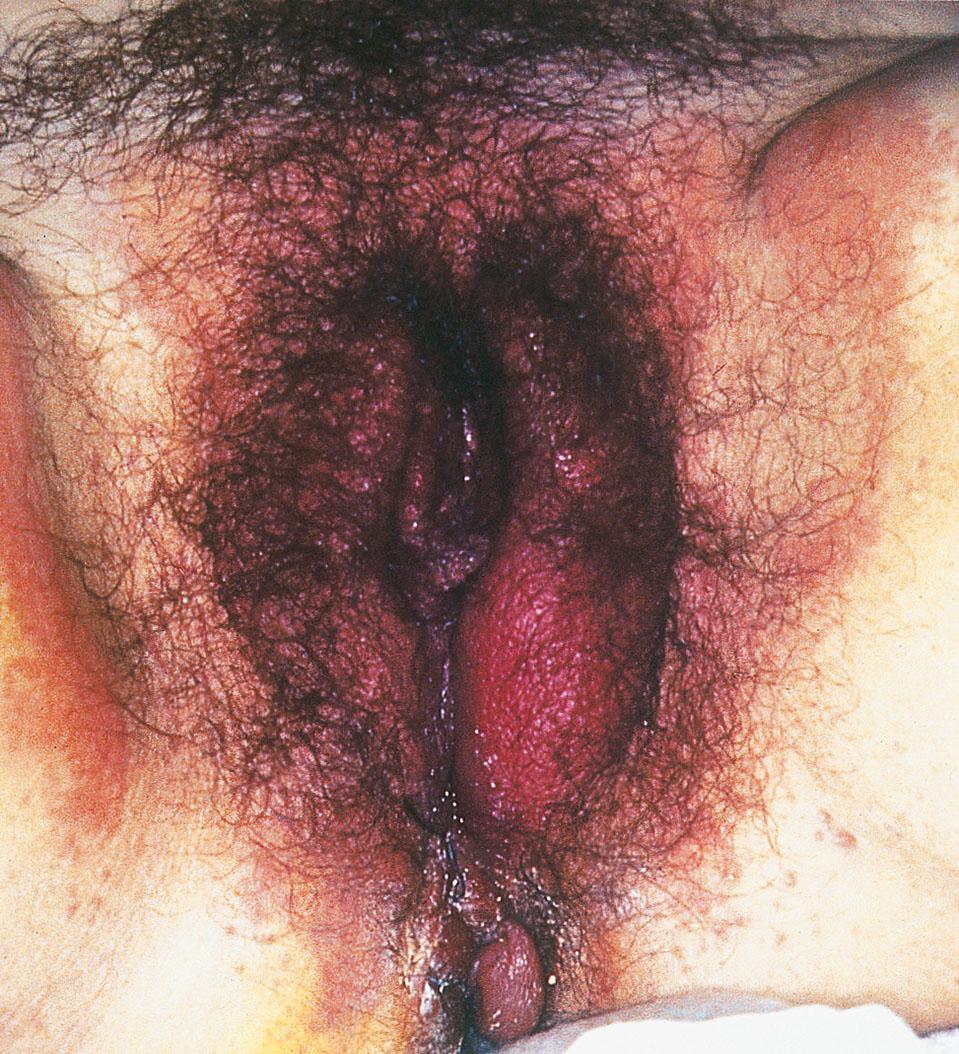
Acute contact dermatitis results in a red, edematous, inflamed skin. The skin may become weeping and eczematoid. The most severe skin reactions form vesicles and at any stage may become secondarily infected. The common symptoms of contact dermatitis include superficial vulvar tenderness, burning, and pruritus. Chronic untreated contact dermatitis can evolve into a syndrome of lichenification, with the skin developing a leathery appearance and texture , known as lichen simplex chronicus ( Fig. 18.12 ).
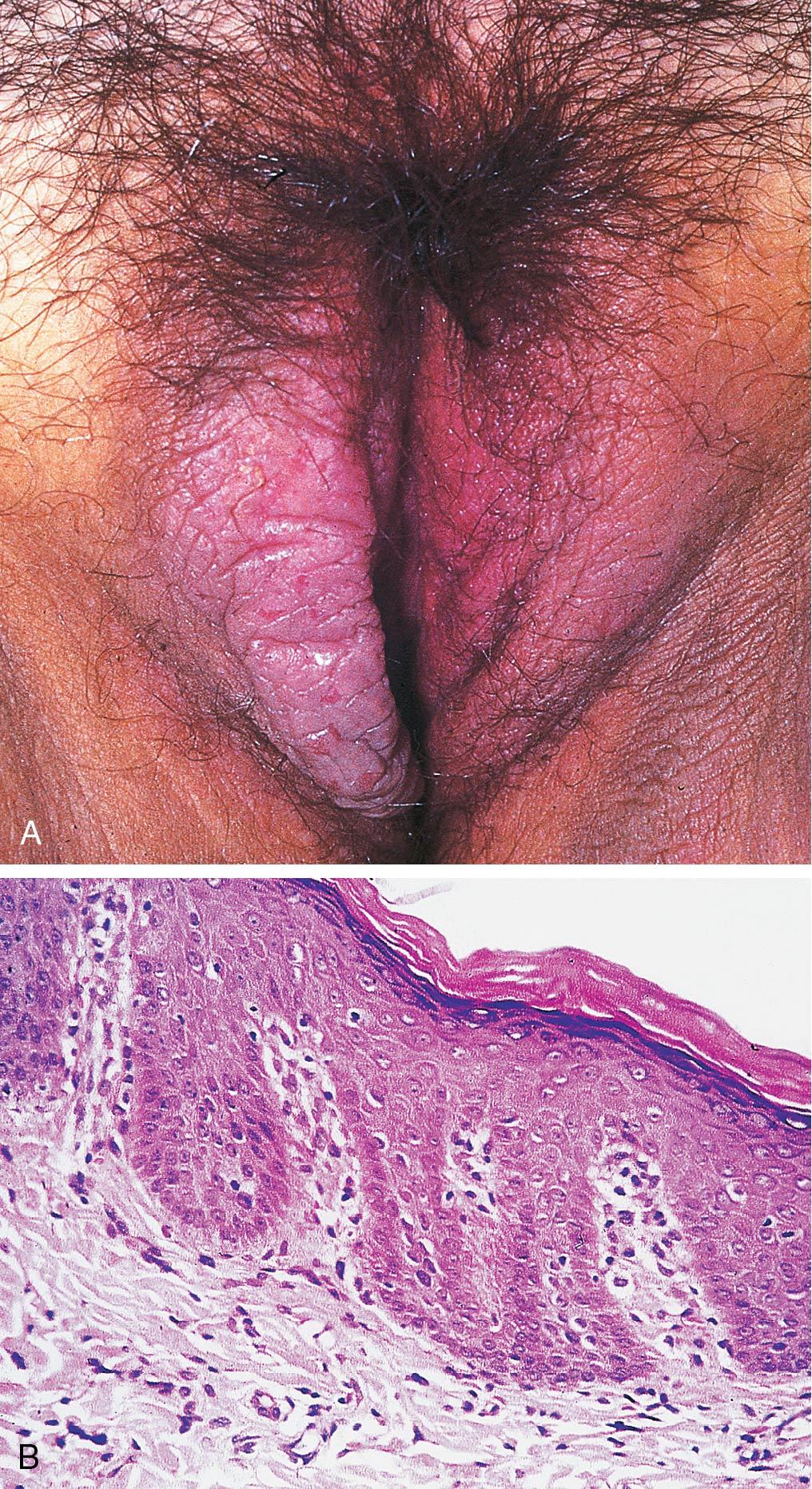
The foundation of treatment of contact dermatitis is withdrawal of the offending substance. Sometimes the distribution of the vulvar erythema helps to delineate the irritant. For example, localized erythema of the introitus often results from vaginal medication, whereas generalized erythema of the vulva is secondary to an allergen in clothing. It is possible to use a vulvar chemical innocuously for many months or years before the topical vulvar “allergy” develops.
Once the offending substances and all potential allergens have been eliminated, topical steroids can be applied to the vulva until the skin returns to normal. The vulvar skin should be kept clean and dry. Use of a barrier product such as zinc oxide ointment or vitamin A and D ointment may be needed to keep urine and feces away from the skin in patients with incontinence. The pain and burning can be treated with tepid water bath soaks several times a day for the first few days. Use of a lubricating agent such as petroleum jelly or Eucerin cream will reduce the pruritus by rehydrating the skin and should be applied after the soaks. Cotton undergarments that allow the vulvar skin to aerate should be worn, and constrictive, occlusive, or tight-fitting clothing such as pantyhose should be avoided. Use of a nonmedicated cornstarch baby powder may facilitate vulvar dryness. Hydrocortisone (0.5% to 1%) and fluorinated corticosteroids (Valisone, 0.1%, or Synalar, 0.01%) as lotions or creams may be rubbed into the skin two to three times a day for a few days to control symptoms. Synthetic systemic corticosteroids (prednisone, starting with 50 mg/day for 7 to 10 days in a decreasing dose) are sometimes necessary for treatment of poison ivy and poison oak or severe reactions. Antipruritic medications, such as antihistamines, are not of great therapeutic benefit except as soporific agents. Women often experience pruritus after steroid therapy for vulvar dermatitis. This is not necessarily a recurrence but rather represents a type of withdrawal reaction. This rebound pruritus is seen most commonly with prolonged and higher doses of steroids. After examination, the optimal treatment is a step-down to a short course of a low-potency topical steroid such as 1% hydrocortisone. Topical steroids should be continued for a month or more after clinical improvement because microscopic evidence of inflammation remains for a considerable period ( ).
Psoriasis is a common, generalized skin disease of unknown origin. Generally, women develop psoriasis during their teenage years, with approximately 3% of adult women affected. Approximately 20% of these cases involve vulvar skin. Similar to candidiasis, psoriasis may be the first clinical manifestation of human immunodeficiency virus (HIV) infection. Psoriasis is chronic and relapsing, with an extremely variable and unpredictable course marked by spontaneous remissions and exacerbations. Twenty-five percent of women have a family history of the disease. Genetic susceptibility to develop psoriasis is believed to be multifactorial. Common areas of involvement are the scalp and fingernails. When psoriasis involves the vulvar skin, it produces both anxiety and embarrassment.
Vulvar psoriasis usually affects intertriginous areas and is manifested by red to red-yellow papules. These papules tend to enlarge, becoming well-circumscribed, dull-red plaques ( Fig. 18.13 ). Though the presence of classic silver scales and bleeding on gentle scraping of the plaques may help establish the diagnosis, the scales are less common in the vulva than on other areas of the body.
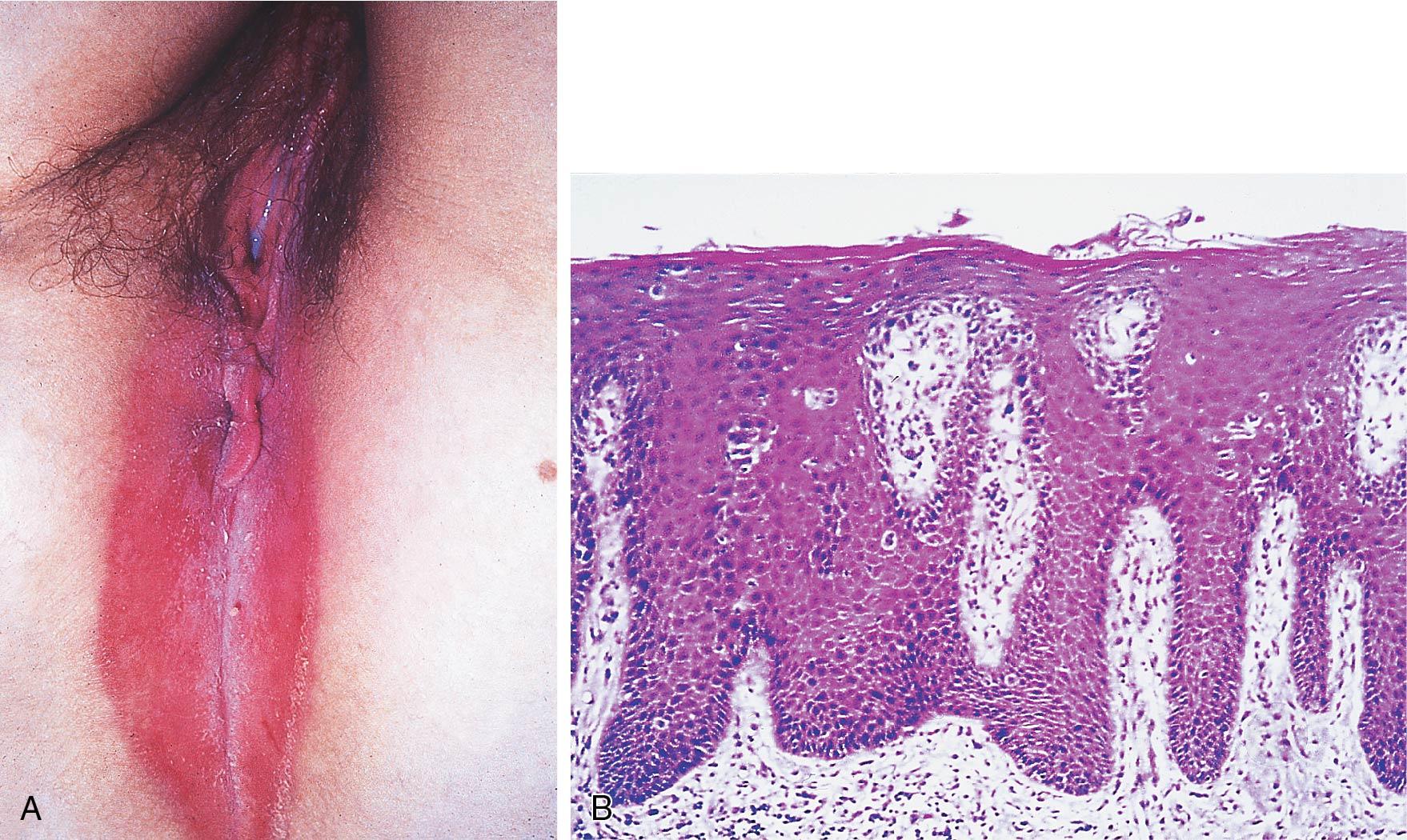
With psoriasis on the vulvar region, the number of scales is extremely variable and often they are absent. Under the influence of the moisture and heat of the vulva, vulvar psoriasis may resemble candidiasis. Importantly for the diagnosis, psoriasis does not involve the vagina. Sometimes dermatologists treat refractory cases of psoriasis with oral retinoids. The margins of psoriasis are more well defined than the common skin conditions in the differential diagnosis, including candidiasis, seborrheic dermatitis, and eczema. Initial treatment for mild disease is 1% hydrocortisone cream. If the patient has pain secondary to chronic fissures or more moderate disease, a 4-week course of a fluorinated corticosteroid cream should be given. If this treatment is not successful, a dermatologist should be consulted. Several newer antipsoriatic treatments may benefit this condition, especially when it becomes moderate to severe, including vitamin D analogs, topical retinoids, calcineurin inhibitors, salicylic acid, coal tar cyclosporine, and drugs that alter the immune system (biologics). Systemic steroids often produce a rebound flare-up of the disease.
Seborrheic dermatitis is a common chronic skin disease of unknown origin that classically affects the face, scalp, sternum, and the area behind the ears. Rarely, the mons pubis and vulvar areas may be involved. Vulvar lesions are pale to yellow-red, erythematous, and edematous, and they are covered by a fine, nonadherent scale that is usually oily. Excessive sweating and emotional tension precipitate attacks. Although the cause is unknown, an abnormal reaction in the skin to a commensal yeast, Pityrosporum ovale, has been implicated in the pathogenesis. Treatment with topical and oral antifungal agents causes improvement; however, they are not as effective as topical steroids ( ). Approximately 2% to 4% of women have some form of the disease. The pruritus associated with seborrheic dermatitis varies from mild to severe. Treatment is similar to that for contact dermatitis, with hydrocortisone cream being the most effective medication. The differential diagnosis of seborrheic dermatitis includes psoriasis, cutaneous candidiasis, and contact dermatitis. Often it is difficult to differentiate between the cutaneous manifestations of psoriasis and seborrheic dermatitis. Clinically and pragmatically the exact diagnosis is only of academic interest because the treatment is similar.
Lichen planus is an uncommon vulvovaginal dermatosis. Women complain of soreness, burning, itching, and dyspareunia. The disease presents most commonly as a hypertrophic, coalesced plaque similar to lichen sclerosis. Lichen sclerosis, though, does not involve the vagina, whereas lichen planus can. Three types of vulvar lichen planus have been described: erosive, classical, and hypertrophic. Erosive lichen planus is the most common and is characterized by erosions around the introitus, clitoris, and labia majora and minora ( Fig. 18.14 ). A lacy white edge is commonly seen. Vaginal involvement is common, and patients may also present with contact bleeding, erythema, and scarring with synechiae. Many patients may also report mouth pain and have gingival lesions that appear erosive and desquamative. The classical type presents with small purple, polygonal papules, with sometimes a reticulate lace pattern. Hyperkeratotic lichen planus presents as single or multiple white, hyperkeratotic papules and plaques. Lichen planus is an inflammatory condition with unknown cause; however, evidence suggests it to be an autoimmune disease of cellular immunity ( ). The autoimmune phenomenon can be triggered by certain drugs, including beta-blockers, angiotensin-converting enzyme (ACE) inhibitors, and other medications. It may also arise spontaneously. The correct diagnosis is confirmed by a small punch biopsy of the vagina or vulva. Histologic findings ( Fig. 18.15 ) include degeneration of the basal layers, a lymphocytic infiltrate of the dermis, and epidermal acanthosis.
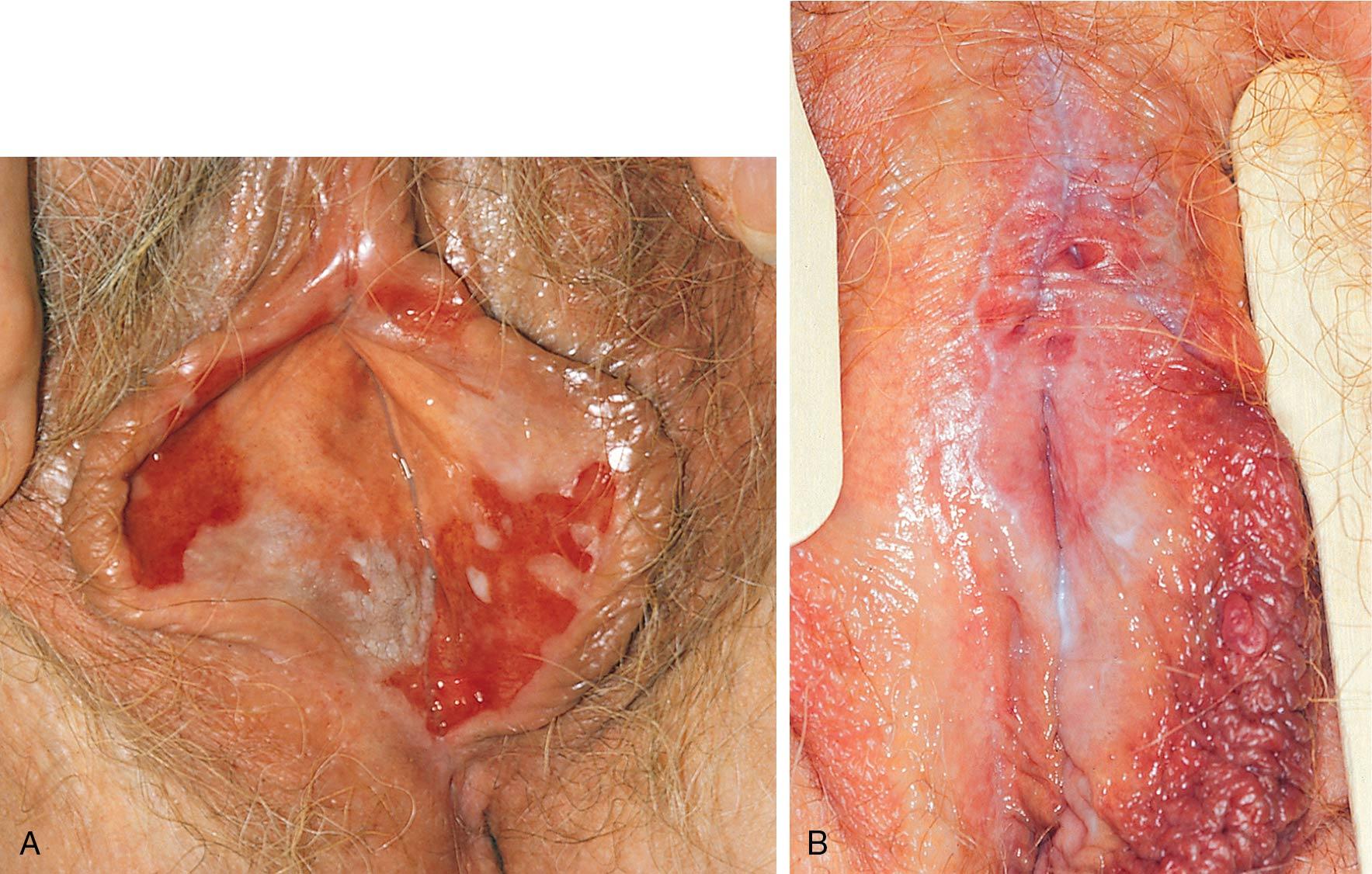

This chronic disease tends to have spontaneous remissions and exacerbations that last for weeks to months. Treatment of local lesions is by use of a potent topical steroid ointment such as clobetasol applied twice daily. Steroid suppositories may be inserted intravaginally at night. If the patient is intensely symptomatic, oral steroids may be necessary. In postmenopausal women, topical or systemic estrogen replacement can also be crucial to avoid additional mucosal thinning. Other treatments for resistant cases include methotrexate, oral retinoids, oral griseofulvin, dapsone, azathioprine, cyclophosphamide, and topical cyclosporine. Surgery may be necessary to separate vaginal adhesions or uncover a buried clitoris. Postoperatively the use of vaginal dilators can prevent scar re-formation. Women with this condition should be monitored at periodic intervals because of an associated increased risk of developing vulvar squamous cell carcinoma.
Behçet disease is a rare disorder initially described as a triad of oral aphthous ulcers, genital aphthous ulcers, and uveitis. It is now known to be a multisystem disease with potential development of problems in many organ systems: skin, joints, cardiovascular, central nervous system, and gastrointestinal tract. The prevalence is high in the Mediterranean region, Middle East, and Japan. Turkey has the highest prevalence, with a rate of 100 to 400 in 100,000 individuals ( ). The diagnosis is made after exclusion of herpetic lesions and other ulcerative diseases. The symptoms respond to topical anesthetics. Severe disease may require antineoplastic therapy including methotrexate, steroids, or other medications.
Become a Clinical Tree membership for Full access and enjoy Unlimited articles
If you are a member. Log in here